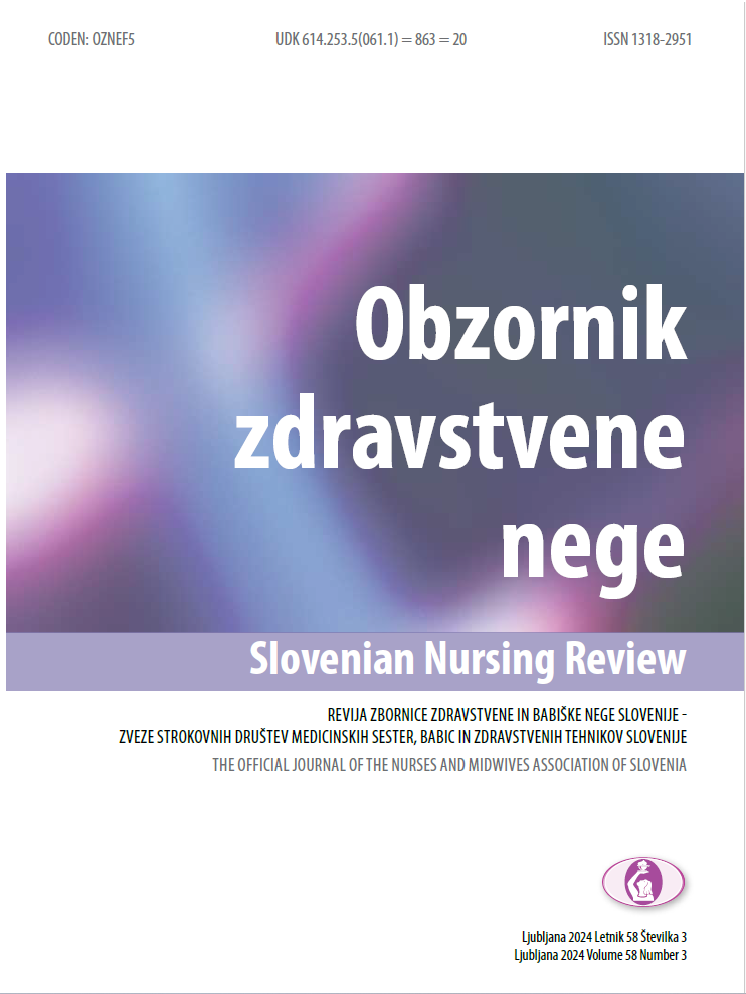The impact of an educational intervention on fertility awareness of healthcare professionals
a cross sectional study
DOI:
https://doi.org/10.14528/snr.2024.58.3.3208Keywords:
preconception health, health care, life-long learningAbstract
Introduction: With couples' increasing postponement of pregnancy to later in life and the associated rising infertility rates, healthcare professionals need to be proactive in counselling on the risk factors affecting reproduction. To do so, they need specific counselling skills and evidence-based information. The aim of this study was to assess and compare participants' knowledge of fertility issues before and after an educational intervention on preconception health care.
Methods: A cross-sectional observational study was conducted, using the same questionnaire to assess the pre- and post-intervention status. The questionnaire was developed on the basis of a literature review on infertility risk factors. The survey was conducted in a conference setting. Participation in the survey was voluntary and confidentiality was assured to all participants (midwives, nurses and healthcare students). The differences in participants' pre- and post-intervention knowledge were calculated using the Wilcoxon signed rank test.
Results: The results of our study show an improvement in participants' overall knowledge on infertility risk factors. These improvements were statistically significant in the sections of 'Age and Fertility' and 'Environmental Hazards', while in the sections 'Pre-existing Medical Conditions' and 'Lifestyle Factors Affecting Fertility', participants already possessed comprehensive knowledge prior to the educational intervention.
Discussion and conclusion: Health professionals can improve their knowledge on preconception health through continuous education. Further studies need to test the long-term effects of different educational approaches.
Downloads
Metrics
References
Barker, M., Dombrowski, S. U., Colbourn, T., Fall, C. H. D., Kriznik, N. M., Lawrence, W. T., & Stephenson, J. (2018). Intervention strategies to improve nutrition and health behaviours before conception. The Lancet, 391(10132), 1853–1864. https://doi.org/10.1016/S0140-6736(18)30313-1 PMid:29673875
Cusack, L., Del Mar, C. B., Chalmers, I., Gibson, E., & Hoffmann, T. C. (2018). Educational interventions to improve people's understanding of key concepts in assessing the effects of health interventions: A systematic review. Systematic Reviews, 7(1), Article 68. https://doi.org/10.1186/s13643-018-0719-4 PMid:29716639; PMCid:PMC5930693
Eurostat. (2021). Fertility statistics. https://ec.europa.eu/eurostat/statistics-explained/index.php?title=Fertility_statistics
Fahy, E., Hardikar, R., Fox, A., & Mackay, S. (2014). Quality of patient health information on the Internet: Reviewing a complex and evolving landscape. The Australasian Medical Journal, 7(1), 24–28. https://doi.org/10.4066/AMJ.2014.1900 PMid:24567763; PMCid:PMC3920473
Goossens, J., De Roose, M., Van Hecke, A., Goemaes, R., Verhaeghe, S., & Beeckman, D. (2018). Barriers and facilitators to the provision of preconception care by health care providers: A systematic review. International Journal of Nursing Studies, 87, 113–130. https://doi.org/10.1016/j.ijnurstu.2018.06.009 PMid:30096578
Hemsing, N., Greaves, L., & Poole, N. (2017). Preconception health care interventions: A scoping review. Sexual & Reproductive Health Care, 14, 24–32. https://doi.org/10.1016/j.srhc.2017.08.004 PMid:29195631
Maeda, E., Miyata, A., Boivin, J., Nomura, K., Kumazawa, Y., Shirasawa, H., & Terada, Y. (2020). Promoting fertility awareness and preconception health using a chatbot: A randomized controlled trial. Reproductive BioMedicine Online, 41(6), 1133–1143. https://doi.org/10.1016/j.rbmo.2020.09.006 PMid:33039321
Mivšek, A. P., & Petročnik, P. (Eds.). (2019). Issues on preconception health care: International scientific conference, 9-10 May 2019. Faculty of Health Sciences. Pal, L., & Santoro, N. (2003). Age-related decline in fertility. Endocrinology and Metabolism Clinics of North America, 32(3), 669–688. https://doi.org/10.1016/s0889-8529(03)00046-x PMid:14560893
PreconNet. (2021). About the project. https://preco.tamk.fi/about-the-project/
Schmidt, L., Sobotka, T., Bentzen, J. G., & Nyboe Andersen, A. (2012). Demographic and medical consequences of the postponement of parenthood. Human Reproduction Update, 18(1), 29–43. https://doi.org/10.1093/humupd/dmr040 PMid:21989171
Shawe, J., Delbaere, I., Ekstrand, M., Hegaard, H. K., Larsson, M., Mastroiacovo, P., & Tydén, T. (2015). Preconception care policy, guidelines, recommendations and services across six European countries: Belgium (Flanders), Denmark, Italy, the Netherlands, Sweden and the United Kingdom. The European Journal of Contraception & Reproductive Health Care, 20(2), 77–87. https://doi.org/10.3109/13625187.2014.990088 PMid:25548961
The Lancet. (2018). Preconception health: Series from the Lancet journals. https://www.thelancet.com/series/preconception-health
Whitworth, M., & Dowswell, T. (2009). Routine pre-pregnancy health promotion for improving pregnancy outcomes. Cochrane Database of Systematic Reviews, (4), Article CD007536. https://doi.org/10.1002/14651858.CD007536.pub2 PMid:19821424; PMCid:PMC4164828
World Health Organization. (2013). Preconception care: Maximizing the gains for maternal and child health. https://www.who.int/maternal_child_adolescent/documents/preconception_care_policy_brief.pdf
Ye, F. Y. (2016). Measuring knowledge: A quantitative approach to knowledge theory. International Journal of Data Science and Analysis, 2(2), 32–36. https://doi.org/10.11648/j.ijdsa.20160202.13
Downloads
Published
How to Cite
Issue
Section
License
Copyright (c) 2023 Slovenian Nursing Review

This work is licensed under a Creative Commons Attribution 4.0 International License.
As the author undersigned hereby, I transfer, assign, or otherwise convey the following authorship rights as comprised in the Copyright and Related Rights Act (CRRA) to the Slovenian Nursing Review, Ob železnici 30A, 1000 Ljubljana: the right of reproduction - the exclusive right to fix the work in a material medium or in another copy directly or indirectly, temporarily or permanently, by any means and in any digital form, in whole or in part (CRRA, Article 23); the right of distribution (CRRA, Article 24); the right of making a work available and accessible through the internet (CRRA, Article 32a); the right of transformation, especially the exclusive right to translate a pre-existing work (CRRA, Article 33). The transfer of author rights applies to the article in its entirety, including pictorial and/or graphic works and possible supplements. The transfer of rights is exclusive and unlimited in duration or territory.
























